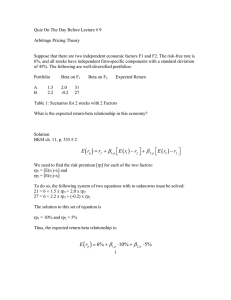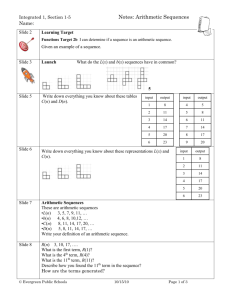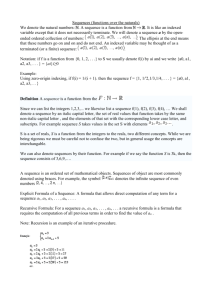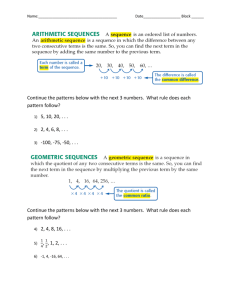Sequences Introduction: Try to discover a pattern in each of the
advertisement
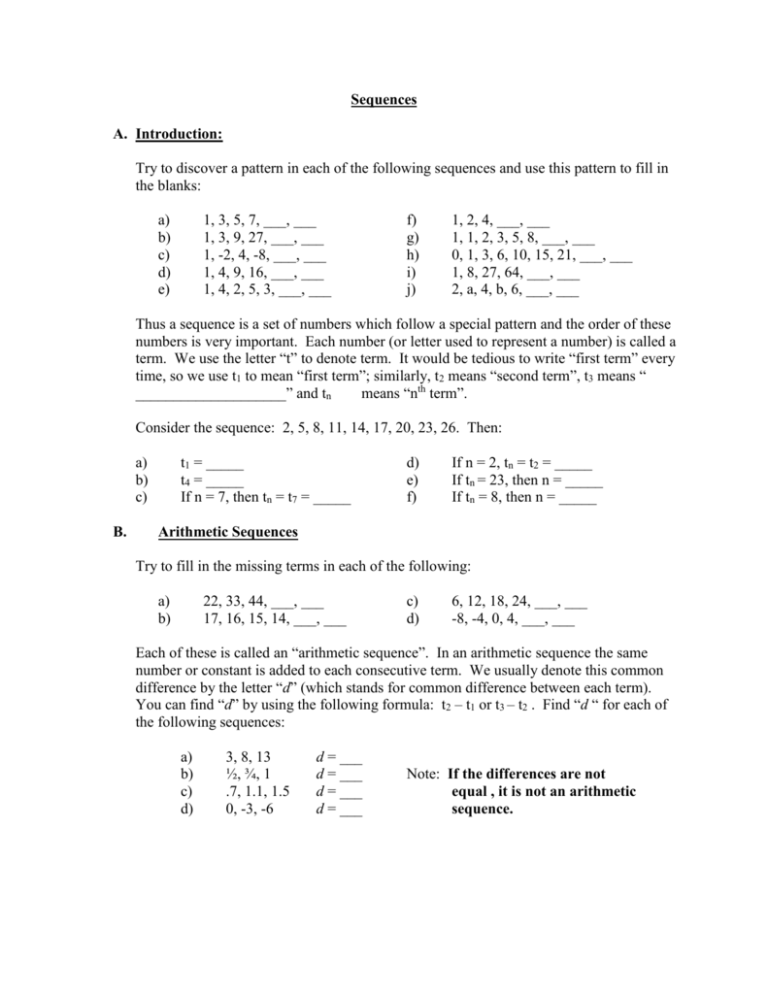
Sequences A. Introduction: Try to discover a pattern in each of the following sequences and use this pattern to fill in the blanks: a) b) c) d) e) 1, 3, 5, 7, ___, ___ 1, 3, 9, 27, ___, ___ 1, -2, 4, -8, ___, ___ 1, 4, 9, 16, ___, ___ 1, 4, 2, 5, 3, ___, ___ f) g) h) i) j) 1, 2, 4, ___, ___ 1, 1, 2, 3, 5, 8, ___, ___ 0, 1, 3, 6, 10, 15, 21, ___, ___ 1, 8, 27, 64, ___, ___ 2, a, 4, b, 6, ___, ___ Thus a sequence is a set of numbers which follow a special pattern and the order of these numbers is very important. Each number (or letter used to represent a number) is called a term. We use the letter “t” to denote term. It would be tedious to write “first term” every time, so we use t1 to mean “first term”; similarly, t2 means “second term”, t3 means “ ____________________” and tn means “nth term”. Consider the sequence: 2, 5, 8, 11, 14, 17, 20, 23, 26. Then: a) b) c) B. t1 = _____ t4 = _____ If n = 7, then tn = t7 = _____ d) e) f) If n = 2, tn = t2 = _____ If tn = 23, then n = _____ If tn = 8, then n = _____ Arithmetic Sequences Try to fill in the missing terms in each of the following: a) b) 22, 33, 44, ___, ___ 17, 16, 15, 14, ___, ___ c) d) 6, 12, 18, 24, ___, ___ -8, -4, 0, 4, ___, ___ Each of these is called an “arithmetic sequence”. In an arithmetic sequence the same number or constant is added to each consecutive term. We usually denote this common difference by the letter “d” (which stands for common difference between each term). You can find “d” by using the following formula: t2 – t1 or t3 – t2 . Find “d “ for each of the following sequences: a) b) c) d) 3, 8, 13 ½, ¾, 1 .7, 1.1, 1.5 0, -3, -6 d = ___ d = ___ d = ___ d = ___ Note: If the differences are not equal , it is not an arithmetic sequence. Suppose we had the sequence 2, 5, 8, … and we were asked to find the 100th term, i.e. t100 . This would not be an easy task to face. But there is a simple formula we can use to find any term we might want. Let’s find this formula. Consider the sequence where t1 = a and d is the common difference. Then our sequence would look like this: t1 = a t5 = a + ___d t2 = a + d t14 = a + ____ t3 = a + ____ (add one more d) t100 = ___________ t4 = a + 3d So, tn = a + (n – 1) d (Be sure you understand this formula. You should memorize it.) Example 1 Find t21 for the sequence 3, 7, 11, … First list your information: t1 = _____ d = _____ n = _____ tn = ? tn = t1 + (n – 1) d , t21 = _____ + (20) 4, t21 = 3 + _____, t21 = ______ a) For the sequence 64, 62, 60, … , find t16. b) For the sequence 1, 9, 17, 25, … , find the 62nd term. c) Find t30 of 20, 15, 10, 5, … d) Find the 41st term of 1, 2.5, 4, 5.5, … Sometimes we are not looking for tn. We might want to find t1 or d or n. 1. Example 2 If 83 is a term of the sequence -8, -1, 6, … , what number term is it? In this problem we know tn = 83, and we want to find n. t1 = _____ d = _____ n=? tn = _____ tn = t1 + (n – 1) d 83 = _____+ (n -1) 7 2. a) b) c) d) e) Then solve for n (you should get n = 14) If t10 = 8 and d = 1, find t1. The first term of the sequence is 7. The constant being added to each consecutive number is 3. Find the 15th term. In the sequence 70, 67, 64, … tn = -2. Find n. t12 = 15 and t13 = 17; find t1. t1 = 3; t23 = 15; find d.





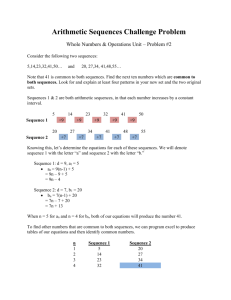
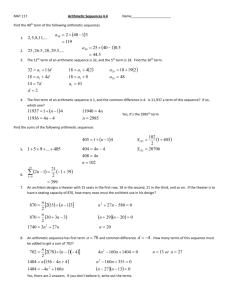
![Information Retrieval June 2014 Ex 1 [ranks 3+5]](http://s3.studylib.net/store/data/006792663_1-3716dcf2d1ddad012f3060ad3ae8022c-300x300.png)
